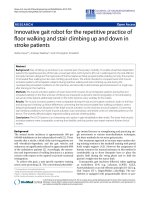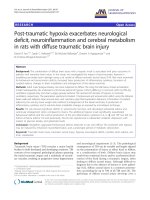Báo cáo hóa học: " Editorial Cross-Layer Design for the Physical, MAC, and Link Layer in Wireless Systems" doc
Bạn đang xem bản rút gọn của tài liệu. Xem và tải ngay bản đầy đủ của tài liệu tại đây (428.81 KB, 3 trang )
Hindawi Publishing Corporation
EURASIP Journal on Advances in Signal Processing
Volume 2009, Article ID 528675, 3 pages
doi:10.1155/2009/528675
Editorial
Cross-Layer Design for the Physical, MAC,
and Link Layer in Wireless Systems
Petar Popovski,
1, 2
Mary Ann Ingram,
3
Christian B. Peel,
4
Shinsuke Hara,
5
and Stavros Toumpis
6
1
Department of Electronic Systems, Aalborg University, Niels Jernes Vej 12, 9220 Aalborg Øst, Denmark
2
Oticon A/S, Kongebakken 9, 2765 Smørum, De nmark
3
School of Electrical and Computer Engineering, Georgia Institute of Technology, 777 Atlantic Drive NW,
Atlanta, GA 30332-0250, USA
4
ArrayComm LLC, San Jose, CA 95131-1014, USA
5
Graduate School of Engineering, Osaka City University, Osaka-shi 558-8585, Japan
6
Department of Electrical and Computer Engineering, University of Cyprus, P.O. Box 20537, 1678 Nicosia, Cyprus
Correspondence should be addressed to Petar Popovski,
Received 14 August 2008; Accepted 14 August 2008
Copyright © 2009 Petar Popovski et al. This is an open access article distributed under the Creative Commons Attribution License,
which permits unrestricted use, distribution, and reproduction in any medium, provided the original work is properly cited.
During the past decade, the research community and wireless
practitioners have provided overwhelming evidence that the
strictly layered ISO/OSI architecture can lead to largely
suboptimal operation of wireless networks. The reasons
for such operation are rooted in the defining features of
wireless communication: the variable link quality and the
fact that the wireless medium should be shared by multiple
users. In order to properly reflect these features in the
protocol stack, the methodology of cross-layer design has
been adopted. In short, the cross-layer methodology allows
certain important information to influence decisions in a
layer that is originally not defined to use that information
(e.g., the SNR information at the link layer or the queue size
at the baseband module).
The motivation for this special issue is the observation
that a cross-layer approach is particularly important when
designing protocols at the physical (PHY) and medium
access control (MAC)/link layer. This is because the defining
wireless features listed above have their strongest impact
on these layers and their interaction. In recent years, the
importance of the cross-layer design at the PHY/MAC/link
layer has been reiterated through the emergence of many
innovative techniques, such as opportunistic communica-
tion, rate adaptation, cross-layered scheduling, and so on.
Judging from those developments, we can expect that cross-
layer solutions at the lowest protocol layers will have a
decisive impact in future wireless networks.
This special issue consists of eleven manuscripts that
clearly advance the state-of-the art in the area of wireless
cross-layer design. They were rigorously selected out of the
29 submitted manuscripts and the reviewers have put much
effort into supporting the review process that, for most
of the manuscripts, had three iterations. We believe that
we have assembled an excellent collection of contributions,
which covers many pertinent aspects of the PHY/MAC/link
layer protocol design and reveals to the public innovative
mechanisms and analysis tools. We have grouped the
manuscripts into four subtopics: (1) reporting/prediction
of fading channels, (2) random access protocols, (3)
downlink resource allocation, and (4) distributed resource
allocation.
Two papers are centered on the features of the fading
channel. Recent advances on the prediction of fading
channels have enabled the reliable prediction of the state
of a channel for travel distances on the order of a few
wavelengths. Ashraf et al., in their work titled “Channel
MAC protocol for opportunistic communication in ad
hoc wireless networks,” use this observation to develop a
MAC protocol under which users transmit depending on
their predictions of the quality of the channel between
them and their destination. The proposed protocol achieves
excellent performance in terms of both throughput, and,
more impressively, fairness. This is yet another excellent, and
highly original, example of the benefits that can be reaped if
2 EURASIP Journal on Advances in Signal Processing
information from the PHY layer is allowed to influence the
operation of the MAC lay er.
The second paper, “Exploiting transmit buffer informa-
tion at the receiver in block-fading channels” by Dinesh
Rajan considers an interesting problem: how to use the
transmit buffer information at the receiver (TBIR) when
the transmitter has a partial channel state information. The
author develops a design framework for systems that utilize
feedback and feed-forward information in block f ading
channels. TBIR is used at the receiver to efficiently quantize
and report the state of the fading channel back to the
transmitter. The results show that this innovative approach
can lead to a reduction of the packet loss as well as power
savings.
The next four papers deal with random access protocols.
The paper by Romaszko and Blondia, entitled “Cross layer
PHY-MAC protocol for wireless static and mobile ad hoc
networks,” introduces a novel protocol for use in ad hoc
networks which performs significantly better, in terms
of delay, throughput, and fairness, with respect to other
currently proposed solutions. The improvement is achieved
by the joint use of a power control algorithm on the PHY
layer and a backoff algorithm on the MAC layer. The protocol
is an excellent example of the gains to be had by a joint design
across these two layers.
The paper “Further development of synchronous array
method for ad hoc networks,” by Yu et al., focuses on
the scheduling and spacing of cochannel transmissions
within a multihop ad hoc network with low mobility. It
extends the evaluation of the opportunistic synchronous
array method (O-SAM) protocol, which adapts to channel
gain variations within a local area or subnet, to general
loading conditions and multiple antennas per node. It also
introduces a distributed synchronous array method (D-
SAM), which combines multislot contention in a control
frame with a “cooperation radius.” D-SAM offers insights
into the fundamental throughput of the 802.16 MSH-DSCH
protocol under low mobility.
In ad hoc networks, the collision avoidance medium
access control (MAC) protocol allowing a single communi-
cation link at a time is not always beneficial, because it limits
the utilization of the spatial resource. The paper by Kusume
et al. entitled “Medium access in spread spectr um ad hoc
networks with multiuser detection” proposes an integrated
design of MAC and physical (PHY) protocols based on
multiuser detection (MUD) to increase the throughput
of ad hoc networks. The proposed MUD-MAC protocol
outperforms the IEEE 802.11 carrier sense multiple access
with collision avoidance (CSMA/CD) protocol in terms of
the overall throughput.
Random packet CDMA (RP-CDMA) is a recent cross-
layer technique that reduces the probability of collision-
induced packet errors by applying multiuser detection. In
“Enhancing the performance of random access networks
with random packet CDMA and joint detection,” Kempter
et al. provide a thorough analysis of the RP-CDMA, by
taking into account realistic physical-layer limitations. The
authors consider the two virtual channels created over the
wireless channel: the header channel and the data channel,
respectively. The system is evaluated for different multiuser
receiver structures in term of throughput and queue sizes.
This paper confirms that the generalization of the notion
of collision through multiuser decoding is an exemplary
topic of the cross-layer design between the physical and the
medium access layer.
Four papers are dedicated to different scenarios/aspects
of the downlink resource allocation. Finding the capacity
of MIMO broadcast channels, a long standing problem in
the information theory community, was recently solved.
Brehmer and Utschick, in their work entitled “Nonconcave
utility maximization in the MIMO broadcast channel,” use
this recently acquired knowledge to develop an algorithm
for performing nonconcave utility maximization in such
channels. They make use of the rich structure of the capacity
region, to solve this tough problem in two steps: in the first
step, the optimal point on the capacity region is determined,
and on the second step the optimum parameter setup is
found.
Zhou and Wunder introduce a scheduling policy which
decomposes the cross-layer delay optimization problem into
two subproblems: allocation of physical resources and user
priority management. In their paper “Throughput-optimal
scheduling with low average delay for cellular broadcast
systems,” the first subproblem is translated into a weighted
sum rate maximization problem that can be efficiently solved
for different channel models. For the second subproblem the
authors present an algorithm which finds delay-minimizing
rate weights. Simulations show that this algorithm gives low
delay and maximum throughput.
For orthogonal frequency division multiple access
(OFDMA) systems, resource allocation, namely, how to
provide adequate subcarriers and data rates while satisfying
each user’s QoS requirement is a challenging problem.
The optimal solution assuming full and perfect channel
state information (CSI) on each user is known, but it
requires not only more computational complexity but also
more bandwidth and time delay on feedback channels. The
paper by Alsawah and Fijalkow entitled “Practical radio
link resource allocation for fair QoS-provision on OFDMA
downlink with partial channel-state information” proposes a
practical resource allocation method utilizing partial CSI of
each user’s average channel gain for an OFDMA single-cell
down link. As compared with the optimal method with full
and perfect CSI, the proposed method offers little spectral
efficiency degradation with the much lower computational
complexity and feedback overhead.
Downlink resource allocation for OFDMA-type sys-
tems with relays is treated in the paper “A coordinated
resource allocation algorithm for infrastructure-based relay
networks” by M
¨
uller et al. The authors propose an allocation
algorithm based on the channel state information (CSI) at
the transmitting base station (BS) and at the transmitting
relay stations (RSs). The cross-layered approach plays a
major role in reconciling the realistic amount of signaled CSI
at the transmitters with the throughput demands set by the
users. The extensive evaluations confirm that the proposed
algorithm is superior to the existing approaches and succeeds
in maximizing the sum rate in a cell, while providing each
EURASIP Journal on Advances in Signal Processing 3
user with the minimal requested data rate and the requested
tolerable error probability.
The last paper considers issues related to distributed
resource al location. In “Adaptive cross-layer distributed
energy-efficient resource allocation algorithms for wireless
data networks,” Buzzi et al. address the problem of adaptive
and distributed implementation of noncooperative games
for energy-efficient resource al location. Readily available
measurements, such as the received data, are utilized for
the adaptive and distributed resource allocation policies
presented. Their stochastic non-cooperative algorithms for
power allocation, spreading code allocation, and choice of
the uplink (linear) receiver are shown via simulation to
approach t he performance of cooperative techniques which
also assume perfect parameter knowledge.
Acknowledgments
The editors would like to thank all the reviewers for their
efforts in making this special issue. They would also like to
thank the Editor-in-Chief, and the editorial staff of Hindawi
Publishing Corporation.
Petar Popovski
Mary Ann Ingram
Christian B. Peel
Shinsuke Hara
Stavros Toumpis









